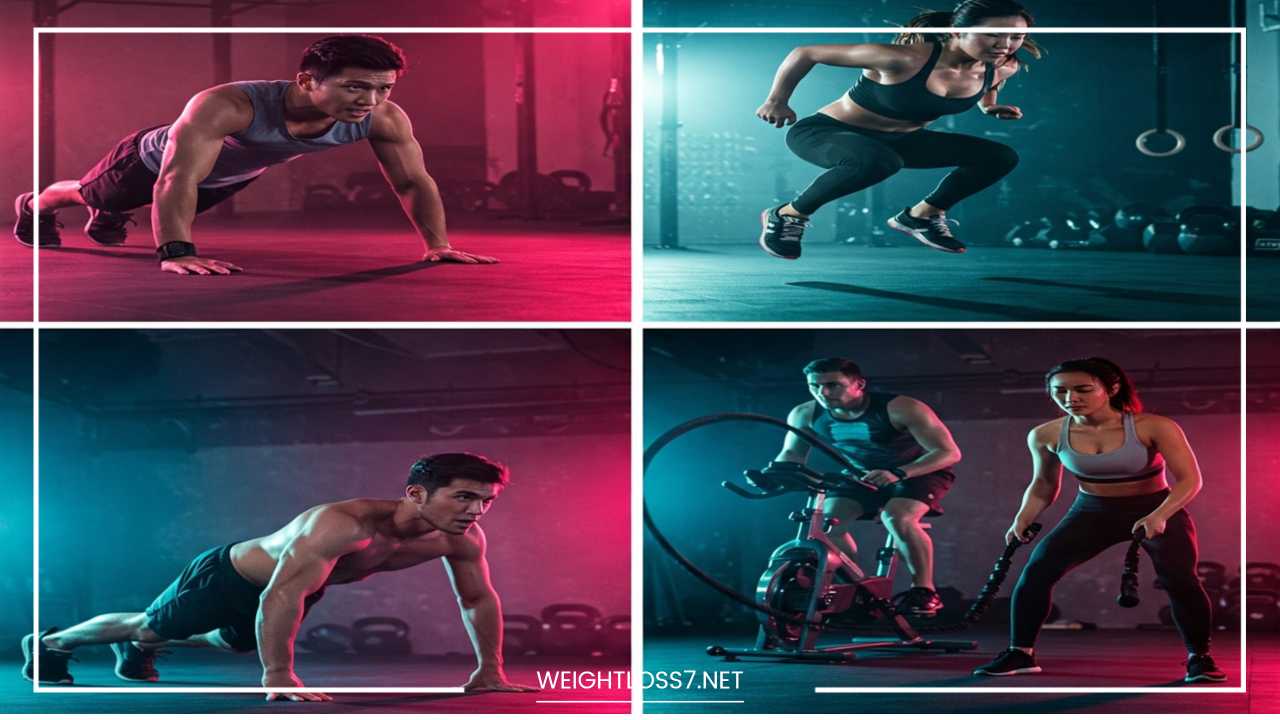Best HIIT Exercises for Fat Loss

Best HIIT Exercises for Fat Loss
Unleash Your Inner Fire: The Ultimate Guide to HIIT Exercises for Fat Loss
In the relentless pursuit of a leaner, healthier physique, the fitness world is constantly evolving, bringing forth innovative and efficient workout methodologies.
Among these, High-Intensity Interval Training (HIIT) has emerged as a true game-changer, captivating fitness enthusiasts and professionals alike with its promise of rapid fat loss and improved cardiovascular health in a fraction of the time compared to traditional steady-state cardio.
If you’re looking to torch calories, melt away stubborn fat, and boost your metabolism without spending hours in the gym, then you’ve landed in the right place.
This comprehensive guide will delve deep into the world of HIIT, exploring the most effective exercises you can incorporate into your routine to achieve your fat loss goals.
We’ll not only list these powerful movements but also break down the science behind their effectiveness, provide detailed instructions on proper form, offer modifications for various fitness levels, and guide you on structuring your HIIT workouts for optimal results.
Get ready to ignite your fitness journey and discover how HIIT can be your secret weapon in the battle against unwanted fat.
What is HIIT and Why is it a Fat Loss Powerhouse?
Before we dive into the specific exercises, let’s lay the groundwork by understanding what HIIT truly entails and why it’s so remarkably effective for fat loss.
At its core, HIIT is a training technique that alternates between short bursts of intense exercise and brief periods of rest or lower-intensity activity.
These high-intensity intervals push your body to its limits, often reaching 80-95% of your maximum heart rate, while the recovery periods allow for partial recuperation before the next intense bout.
The magic of HIIT lies in its ability to trigger a cascade of physiological responses that contribute significantly to fat loss:
- Enhanced Calorie Burn: During the high-intensity intervals, your body expends a significant amount of energy in a short period. This leads to a higher overall calorie burn compared to steady-state cardio performed for the same duration.
- The Afterburn Effect (EPOC): This is perhaps the most significant advantage of HIIT for fat loss. Excess Post-exercise Oxygen Consumption (EPOC) refers to the elevated rate of oxygen consumption that continues after your workout has ended. Your body works to restore itself to its pre-exercise state, which requires energy and thus burns more calories for hours, even up to 24-48 hours, after your HIIT session.
- Metabolic Boost: Regular HIIT workouts can help improve your metabolic rate over time, making your body more efficient at burning calories even at rest.
- Improved Insulin Sensitivity: HIIT has been shown to improve insulin sensitivity, which is crucial for regulating blood sugar levels and preventing fat storage.
- Muscle Preservation: Unlike prolonged steady-state cardio, which can sometimes lead to muscle loss, HIIT can help preserve and even build lean muscle mass, especially when combined with resistance training. More muscle mass means a higher resting metabolic rate, further aiding in fat loss.
- Time Efficiency: HIIT workouts are typically shorter than traditional cardio sessions, making them ideal for individuals with busy schedules. You can achieve significant results with just 20-30 minutes of HIIT a few times a week.
Key Principles for Effective HIIT and Fat Loss
While the intensity of the exercises is crucial in HIIT, several other principles contribute to its effectiveness for fat loss:
- High Intensity: During the work intervals, you should be pushing yourself close to your maximum effort. You should feel significantly challenged and find it difficult to hold a conversation.
- Short Bursts: The high-intensity intervals are typically short, ranging from 20 seconds to a few minutes. This allows you to maintain a high level of exertion throughout the interval.
- Strategic Recovery: The rest or low-intensity periods are crucial for allowing your body to recover enough to tackle the next high-intensity interval with sufficient effort. The duration of the recovery period often matches or slightly exceeds the work interval.
- Proper Form: Maintaining correct form is paramount to prevent injuries and ensure that you are effectively targeting the intended muscle groups. Don’t sacrifice form for speed or intensity, especially when starting.
- Progressive Overload: As your fitness level improves, you’ll need to gradually increase the intensity, duration, or frequency of your HIIT workouts to continue challenging your body and seeing results.
- Consistency: Like any fitness regimen, consistency is key to achieving sustainable fat loss with HIIT. Aim for a few HIIT sessions per week, allowing adequate rest in between.
Factors to Consider Before Diving into HIIT
Before you jump into a high-intensity workout, it’s essential to consider a few factors:
- Current Fitness Level: If you’re new to exercise or have been inactive for a while, it’s best to start with lower-impact HIIT exercises and gradually increase the intensity and duration as your fitness improves.
- Health Conditions: If you have any underlying health conditions, such as cardiovascular issues, joint problems, or injuries, it’s crucial to consult with your doctor before starting HIIT. They can advise you on whether it’s safe for you and suggest modifications if necessary.
- Warm-up and Cool-down: Never skip your warm-up and cool-down. A proper warm-up prepares your body for the intense activity, reducing the risk of injury, while a cool-down helps your body gradually return to its resting state and minimizes muscle soreness.
- Listen to Your Body: Pay attention to your body’s signals. If you feel excessive pain or discomfort, stop the exercise immediately and rest. It’s important to push yourself, but not to the point of injury.
The Importance of Warm-up and Cool-down for HIIT
A well-structured warm-up and cool-down are integral parts of any effective and safe HIIT workout.
Warm-up (5-10 minutes): The purpose of a warm-up is to gradually increase your heart rate, body temperature, and blood flow to your muscles, preparing them for the demands of the workout. A good warm-up should include:
- Light Cardiovascular Activity: Gentle exercises like jogging in place, jumping jacks, or high knees for a few minutes.
- Dynamic Stretching: Movements that take your joints through their full range of motion, such as arm circles, leg swings, torso twists, and hip circles.
Cool-down (5-10 minutes): The cool-down helps your body transition back to a resting state, preventing dizziness and muscle stiffness. It typically involves:
- Light Cardiovascular Activity: Gradually decreasing the intensity of your workout, such as walking after sprinting.
- Static Stretching: Holding each stretch for 20-30 seconds, focusing on the major muscle groups worked during the HIIT session. Examples include hamstring stretches, quad stretches, calf stretches, and chest stretches.
The Best Bodyweight HIIT Exercises for Fat Loss
Bodyweight HIIT exercises are fantastic because they require no equipment and can be done anywhere, making them incredibly convenient. Here are some of the most effective bodyweight exercises for fat loss:
-
Burpees: This full-body exercise is a powerhouse for calorie burning.
- How to Perform: Stand with your feet shoulder-width apart. Squat down and place your hands on the floor in front of you. Kick your feet back into a plank position. Perform a push-up (optional). Jump your feet back to your hands. Explosively jump up, reaching your arms overhead.
- Intensity Level: High
- Modification (Beginner): Skip the push-up or step your feet back and forward instead of jumping.
- Modification (Advanced): Add a tuck jump at the end.
-
Jump Squats: A plyometric exercise that targets your lower body and elevates your heart rate.
- How to Perform: Stand with your feet shoulder-width apart. Lower into a squat position, keeping your chest up and back straight. Explosively jump upwards, extending your legs fully in the air. Land softly back into the squat position.
- Intensity Level: High
- Modification (Beginner): Perform regular squats without the jump.
- Modification (Advanced): Hold a dumbbell or wear a weighted vest.
-
Mountain Climbers: An excellent exercise for engaging your core, shoulders, and legs while boosting your heart rate.
- How to Perform: Start in a plank position with your hands shoulder-width apart. Bring one knee towards your chest, keeping your core engaged. Quickly alternate legs, as if you are running in place while maintaining the plank position.
- Intensity Level: High
- Modification (Beginner): Perform the movement slowly, focusing on proper form.
- Modification (Advanced): Increase the speed of the leg movements.
-
Jumping Jacks: A classic cardio exercise that works multiple muscle groups.
- How to Perform: Stand with your feet together and arms at your sides. Jump your feet out to the sides while simultaneously raising your arms overhead. Jump back to the starting position.
- Intensity Level: Moderate to High
- Modification (Beginner): Perform step jacks, stepping one leg out at a time instead of jumping.
- Modification (Advanced): Increase the speed and range of motion.
-
High Knees: A dynamic exercise that targets your hip flexors, quads, and core.
- How to Perform: Stand with your feet hip-width apart. Bring one knee towards your chest, lifting it as high as possible. Quickly alternate legs, maintaining a fast pace. Pump your arms as if you are running.
- Intensity Level: Moderate to High
- Modification (Beginner): Perform the movement slowly, focusing on lifting your knees as high as comfortably possible.
- Modification (Advanced): Increase the speed and height of your knees.
-
Butt Kicks: Another great cardio exercise that targets your hamstrings and glutes.
- How to Perform: Stand with your feet hip-width apart. Bring one heel towards your glutes, trying to touch it with your hand. Quickly alternate legs, maintaining a fast pace. Pump your arms as if you are running.
- Intensity Level: Moderate to High
- Modification (Beginner): Perform the movement slowly, focusing on bringing your heel as close to your glutes as comfortably possible.
- Modification (Advanced): Increase the speed and height of your heels.
-
Jumping Lunges: A challenging exercise that works your quads, hamstrings, and glutes while improving balance and coordination.
- How to Perform: Start in a lunge position with your front knee bent at a 90-degree angle and your back knee hovering just above the ground. Explosively jump upwards, switching your legs mid-air so that you land in a lunge with the opposite leg forward.
- Intensity Level: High
- Modification (Beginner): Perform regular lunges without the jump, alternating legs.
- Modification (Advanced): Hold dumbbells or wear a weighted vest.
-
Plank Jacks: A variation of the plank that adds a cardiovascular element and further engages your core.
- How to Perform: Start in a plank position with your hands shoulder-width apart and your body in a straight line from head to heels. Jump your feet out to the sides, wider than shoulder-width apart. Jump your feet back to the starting position.
- Intensity Level: Moderate to High
- Modification (Beginner): Perform regular planks or step your feet out one at a time.
- Modification (Advanced): Increase the speed of the jumps.
-
Squat Thrusts: A dynamic exercise that combines a squat and a plank, engaging multiple muscle groups.
- How to Perform: Stand with your feet shoulder-width apart. Squat down and place your hands on the floor in front of you. Jump your feet back into a plank position. Immediately jump your feet back to your hands. Stand back up.
- Intensity Level: High
- Modification (Beginner): Step your feet back and forward instead of jumping.
- Modification (Advanced): Add a push-up in the plank position or a jump at the end.
-
Lateral Shuffle: A great exercise for improving agility and working your outer and inner thighs.
- How to Perform: Stand with your feet hip-width apart and knees slightly bent. Shuffle to one side for a few steps, then quickly shuffle back to the starting position. Keep your feet close to the ground and maintain a low stance.
- Intensity Level: Moderate
- Modification (Beginner): Reduce the speed and distance of the shuffles.
- Modification (Advanced): Increase the speed and distance, or touch the ground with your hand at each end.
The Best Equipment-Based HIIT Exercises for Fat Loss
While bodyweight exercises are excellent, incorporating equipment can add variety and challenge to your HIIT workouts. Here are some effective equipment-based HIIT exercises for fat loss:
-
Sprinting on a Treadmill: An excellent way to elevate your heart rate and burn a significant number of calories.
- How to Perform: Warm up thoroughly. Set the treadmill to a challenging incline (optional). Sprint at a high intensity for a set interval (e.g., 30 seconds). Reduce the speed to a walk or jog for the recovery interval (e.g., 60 seconds). Repeat for the desired number of rounds.
- Intensity Level: High
- Modification (Beginner): Start with shorter sprint intervals and longer recovery periods. Reduce the incline.
- Modification (Advanced): Increase the sprint duration, incline, or speed.
-
Cycling Sprints on a Stationary Bike: A low-impact option that still provides a high-intensity workout.
- How to Perform: Adjust the bike to your height. Warm up. Pedal at a very high resistance and speed for a set interval (e.g., 30 seconds). Reduce the resistance and pedal at a slow pace for the recovery interval (e.g., 60 seconds). Repeat for the desired number of rounds.
- Intensity Level: High
- Modification (Beginner): Start with shorter sprint intervals and longer recovery periods. Reduce the resistance.
- Modification (Advanced): Increase the sprint duration, resistance, or speed.
-
Rowing Machine Intervals: A full-body workout that engages your legs, core, and arms.
- How to Perform: Learn the proper rowing technique. Warm up. Row at a high intensity, focusing on powerful leg drive, for a set interval (e.g., 45 seconds). Reduce your effort and row at a slower pace for the recovery interval (e.g., 45 seconds). Repeat for the desired number of rounds.
- Intensity Level: Moderate to High
- Modification (Beginner): Start with shorter work intervals and longer recovery periods. Focus on proper form over speed.
- Modification (Advanced): Increase the work duration or intensity.
-
Kettlebell Swings: A dynamic exercise that works your posterior chain (glutes, hamstrings, lower back) and core.
- How to Perform: Stand with your feet slightly wider than shoulder-width apart, holding a kettlebell with both hands. Hinge at your hips, swinging the kettlebell back between your legs. Explosively drive your hips forward, swinging the kettlebell up to chest height. Control the descent back to the starting position.
- Intensity Level: Moderate to High
- Modification (Beginner): Start with lighter weight and focus on the hip hinge movement.
- Modification (Advanced): Increase the weight or duration of the swings.
-
Battle Ropes: An engaging exercise that works your arms, shoulders, core, and back while providing a cardiovascular challenge.
- How to Perform: Secure the battle ropes around a sturdy anchor. Stand with your feet shoulder-width apart, holding one end of the rope in each hand. Create waves by alternately raising and lowering your arms rapidly. Experiment with different movements like slams, circles, and lateral waves. Perform for a set interval (e.g., 30 seconds) followed by a recovery period.
- Intensity Level: Moderate to High
- Modification (Beginner): Use lighter ropes or perform shorter work intervals.
- Modification (Advanced): Increase the rope thickness, work duration, or try more complex movements.
-
Jump Rope: A simple yet highly effective exercise for improving cardiovascular fitness and coordination.
- How to Perform: Hold the handles of the jump rope. Swing the rope over your head and jump over it with both feet. Maintain a consistent rhythm. Perform for a set interval (e.g., 60 seconds) followed by a recovery period.
- Intensity Level: Moderate to High
- Modification (Beginner): Start with shorter intervals and focus on mastering the basic jump.
- Modification (Advanced): Try variations like single-leg jumps, double unders, or high knees while jumping.
-
Medicine Ball Slams: A powerful exercise that engages your core, arms, and shoulders while releasing tension.
- How to Perform: Stand with your feet shoulder-width apart, holding a medicine ball overhead with both hands. Engage your core and forcefully slam the ball down onto the ground in front of you. Catch the ball as it bounces back up (if it does) and repeat. Perform for a set interval followed by a recovery period.
- Intensity Level: High
- Modification (Beginner): Use a lighter medicine ball or perform controlled overhead throws instead of slams.
- Modification (Advanced): Use a heavier ball or increase the speed and power of the slams.
-
Box Jumps: A plyometric exercise that builds explosive power in your legs and glutes.
- How to Perform: Stand facing a sturdy box or platform. Start with a low box and gradually increase the height as you get fitter. Bend your knees and explosively jump onto the box, landing softly with bent knees. Step or jump back down. Perform for a set number of repetitions or a time interval.
- Intensity Level: High
- Modification (Beginner): Start with a very low box or perform step-ups instead.
- Modification (Advanced): Increase the height of the box or perform consecutive jumps.
-
TRX Suspension Training: Utilizing suspension straps allows for a wide variety of HIIT exercises that engage your core and work multiple muscle groups simultaneously. Exercises like TRX squats, rows, push-ups, and mountain climbers can be incorporated into a HIIT routine.
- How to Perform: Learn the basics of TRX training and proper form for each exercise. Adjust the strap length to modify the intensity. Perform each exercise for a set interval followed by a recovery period.
- Intensity Level: Varies depending on the exercise and strap angle.
- Modification (Beginner): Increase the angle of your body to reduce the resistance.
- Modification (Advanced): Decrease the angle of your body or perform more challenging variations.
-
Agility Ladder Drills: While not directly focused on strength, agility ladder drills are fantastic for improving footwork, coordination, and cardiovascular fitness, making them a great addition to a well-rounded HIIT program. Exercises like quick feet, lateral shuffles, and in-and-outs can be performed for set time intervals.
- How to Perform: Lay the agility ladder flat on the ground. Perform various footwork patterns within the ladder squares, focusing on speed and precision.
- Intensity Level: Moderate to High
- Modification (Beginner): Start with slower movements and focus on accuracy.
- Modification (Advanced): Increase the speed and complexity of the drills.
Structuring Your HIIT Workout for Optimal Fat Loss
There’s no one-size-fits-all approach to structuring a HIIT workout, but here are some general guidelines to consider:
- Work-to-Rest Ratio: A common ratio is 1:1 or 2:1 (e.g., 30 seconds of work followed by 30 or 15 seconds of rest). However, you can adjust this based on your fitness level and the specific exercises you’re performing. More intense exercises may require longer rest periods.
- Interval Duration: Work intervals can range from 20 seconds to a few minutes. Shorter intervals (20-30 seconds) are often used for very high-intensity exercises, while longer intervals (1-3 minutes) can be used for slightly less intense but still challenging movements.
- Number of Rounds: The total number of rounds will depend on the duration of your intervals and your fitness level. Aim for around 4-10 rounds in a typical HIIT workout.
- Total Workout Duration: A HIIT workout can last anywhere from 15 to 30 minutes, including the warm-up and cool-down.
- Frequency: Aim for a few HIIT sessions per week, with rest days in between to allow your body to recover.
Example HIIT Workout Structure:
- Warm-up: 5 minutes of light cardio and dynamic stretching.
- Exercise 1 (e.g., Burpees): 30 seconds of high-intensity work.
- Rest: 30 seconds of rest.
- Exercise 2 (e.g., Jump Squats): 30 seconds of high-intensity work.
- Rest: 30 seconds of rest.
- Exercise 3 (e.g., Mountain Climbers): 30 seconds of high-intensity work.
- Rest: 30 seconds of rest.
- Exercise 4 (e.g., Jumping Jacks): 30 seconds of high-intensity work.
- Rest: 30 seconds of rest.
- Repeat the circuit 2-3 more times.
- Cool-down: 5 minutes of light cardio and static stretching.
Combining HIIT with Nutrition for Maximum Results
While HIIT is incredibly effective for fat loss, it’s crucial to remember that it’s only one piece of the puzzle. To achieve optimal and sustainable results, you need to combine your HIIT workouts with a healthy and balanced diet.
Focus on consuming whole, unprocessed foods, including lean protein, complex carbohydrates, healthy fats, and plenty of fruits and vegetables. Pay attention to your calorie intake and ensure you are in a slight calorie deficit to promote fat loss.
Safety Tips for HIIT Workouts
- Start Slowly: If you’re new to HIIT, don’t try to do too much too soon. Gradually increase the intensity and duration of your workouts as your fitness improves.
- Listen to Your Body: Pay attention to any pain or discomfort and stop if you need to.
- Stay Hydrated: Drink plenty of water before, during, and after your workouts.
- Use Proper Form: Focus on maintaining correct form to prevent injuries. If you’re unsure about the proper technique, consider watching videos or consulting with a fitness professional.
- Allow for Adequate Rest: Make sure you get enough sleep and allow for rest days between your HIIT sessions.
Sample HIIT Workout Plans
Here are a couple of sample HIIT workout plans for different fitness levels:
Beginner HIIT Workout (20 minutes total):
- Warm-up: 5 minutes of light cardio (e.g., marching in place, arm circles).
- Circuit (Repeat 3 times with 1 minute rest between rounds):
- Walking Lunges: 30 seconds
- Rest: 30 seconds
- Step Jacks: 30 seconds
- Rest: 30 seconds
- Bodyweight Squats: 30 seconds
- Rest: 30 seconds
- Plank (on knees if needed): 30 seconds
- Rest: 30 seconds
- Cool-down: 5 minutes of gentle stretching.
Intermediate HIIT Workout (25 minutes total):
- Warm-up: 5 minutes of jogging in place and dynamic stretching.
- Circuit (Repeat 4 times with 45 seconds rest between rounds):
- Burpees (modified if needed): 45 seconds
- Rest: 30 seconds
- Jump Squats: 45 seconds
- Rest: 30 seconds
- Mountain Climbers: 45 seconds
- Rest: 30 seconds
- Jumping Lunges: 45 seconds
- Rest: 30 seconds
- Cool-down: 5 minutes of static stretching.
Advanced HIIT Workout (30 minutes total):
- Warm-up: 5 minutes of dynamic stretching and light plyometrics.
- Circuit (Repeat 5 times with 30 seconds rest between rounds):
- Burpees with Tuck Jump: 45 seconds
- Rest: 15 seconds
- Kettlebell Swings: 45 seconds
- Rest: 15 seconds
- Sprinting on Treadmill (incline optional): 45 seconds
- Rest: 15 seconds
- Box Jumps: 45 seconds
- Rest: 15 seconds
- Cool-down: 5 minutes of foam rolling and static stretching.
Tracking Your Progress and Staying Motivated
To stay motivated and track your progress, consider these tips:
- Keep a Workout Journal: Record your workouts, including the exercises you did, the duration of your intervals, the number of rounds, and how you felt.
- Take Progress Photos: Visual progress can be a powerful motivator. Take photos of yourself regularly to track changes in your physique.
- Set Realistic Goals: Set achievable short-term and long-term goals to keep you focused and motivated.
- Find a Workout Buddy: Exercising with a friend can provide accountability and make your workouts more enjoyable.
- Listen to Your Favorite Music: Upbeat music can help you push through tough intervals.
- Celebrate Your Successes: Acknowledge and reward yourself for reaching milestones.
Final Thoughts: Ignite Your Fat Loss Journey with HIIT
HIIT is a highly effective and time-efficient training method for achieving your fat loss goals. By incorporating the best HIIT exercises discussed in this guide into your routine and following the principles of intensity, strategic recovery, and proper form, you can unlock your body’s fat-burning potential.
Remember to listen to your body, progress gradually, and combine your workouts with a healthy diet for optimal and sustainable results.
So, are you ready to unleash your inner fire and transform your physique with the power of HIIT? The journey to a leaner, healthier you starts now!

















